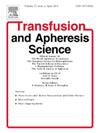Quality control perspectives: Weak signal detection to prevent clinical sensitivity failures in donors' screening
IF 1.2
4区 医学
Q4 HEMATOLOGY
引用次数: 0
Abstract
Ensuring the accuracy of donor screening examinations is critical to minimizing the risk of transfusion-transmissible infections. Weak signals, which refer to low-intensity examination responses near the detection threshold, pose a challenge in distinguishing true positive results from background noise, which leads to the increasing likelihood of misclassification. Screening immunoassays are more susceptible to weak signal issues than nucleic acid tests (NAT) due to the inherent amplification step in NAT, which enhances sensitivity. This article explores the risks associated with weak signal detection failures, the necessity of cutoff protection, and the role of verification and validation targeted samples. Additionally, it discusses the importance of internal quality control and external quality assessment strategies to mitigate the limitations of using high-signal samples in donor screening.
质量控制观点:弱信号检测防止供体筛选临床敏感性失败
确保献血者筛选检查的准确性对于尽量减少输血传播感染的风险至关重要。弱信号是指接近检测阈值的低强度检查响应,它对区分真阳性结果和背景噪声构成挑战,从而导致误分类的可能性增加。由于核酸检测固有的扩增步骤,筛选免疫检测比核酸检测更容易受到弱信号问题的影响,从而提高了灵敏度。本文探讨了与弱信号检测失败相关的风险,截止保护的必要性,以及验证和验证目标样本的作用。此外,它还讨论了内部质量控制和外部质量评估策略的重要性,以减轻在供体筛选中使用高信号样本的局限性。
本文章由计算机程序翻译,如有差异,请以英文原文为准。
求助全文
约1分钟内获得全文
求助全文
来源期刊
CiteScore
3.60
自引率
5.30%
发文量
181
审稿时长
42 days
期刊介绍:
Transfusion and Apheresis Science brings comprehensive and up-to-date information to physicians and health care professionals involved in the rapidly changing fields of transfusion medicine, hemostasis and apheresis. The journal presents original articles relating to scientific and clinical studies in the areas of immunohematology, transfusion practice, bleeding and thrombotic disorders and both therapeutic and donor apheresis including hematopoietic stem cells. Topics covered include the collection and processing of blood, compatibility testing and guidelines for the use of blood products, as well as screening for and transmission of blood-borne diseases. All areas of apheresis - therapeutic and collection - are also addressed. We would like to specifically encourage allied health professionals in this area to submit manuscripts that relate to improved patient and donor care, technical aspects and educational issues.
Transfusion and Apheresis Science features a "Theme" section which includes, in each issue, a group of papers designed to review a specific topic of current importance in transfusion and hemostasis for the discussion of topical issues specific to apheresis and focuses on the operators'' viewpoint. Another section is "What''s Happening" which provides informal reporting of activities in the field. In addition, brief case reports and Letters to the Editor, as well as reviews of meetings and events of general interest, and a listing of recent patents make the journal a complete source of information for practitioners of transfusion, hemostasis and apheresis science. Immediate dissemination of important information is ensured by the commitment of Transfusion and Apheresis Science to rapid publication of both symposia and submitted papers.

 求助内容:
求助内容: 应助结果提醒方式:
应助结果提醒方式:


